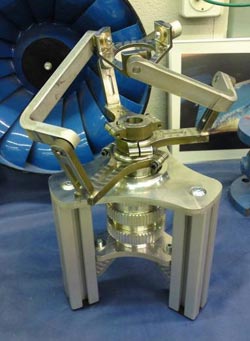Penguin-inspired propulsion system

This actuated spherical joint mimics a penguin shoulder while enabling compactness, rigidity and high motion frequencies, as well as unlimited rotation (propeller-like, not shown on the video) about a single shaft.<br><br>Credit: hepia/B.Sudki-M.Lauria-F.Noca<br>
That's all it took to inspire Flavio Noca, who at the time was a graduate student in Caltech's Aeronautics Department, and now teaches aerodynamics at the University of Applied Sciences Western Switzerland (hepia) and the Swiss Federal Institute of Technology (EPFL), to explore leveraging penguins' “rocket” properties to create new propulsion technologies with high maneuverability and improved hydrodynamic efficiency.
At the American Physical Society's (APS) Division of Fluid Dynamics meeting, Nov. 24 – 26, in Pittsburgh, Pa, Noca will present a penguin-inspired propulsion system that uses a novel spherical joint mechanism developed and manufactured by Bassem Sudki, a research assistant within Noca's aerodynamics group, under the supervision of Professor Michel Lauria who leads hepia's Robotics Laboratory.
Based on a penguin's shoulder-and-wing system, the mechanism features a spherical joint that enables three degrees of freedom and a fixed center of rotation. “Unlike an animal shoulder joint, however, this spherical joint enables unlimited rotational range about the main shaft axis like a propeller,” Noca said.
To achieve this they needed to overcome the technical challenges of spherical joints, such as the lack of rigidity and the inability to generate high torques. To understand the challenge involved, just try lifting a 10-pound weight on your hand with your arm extended.
The researchers maneuvered around these challenges by choosing a parallel robotic architecture for this type of mechanism, because it enables rigidity as well as high actuation frequencies and amplitudes.
“Because the motors are fixed, inertial forces are lower than for a serial robotic mechanism, such as a multi-joint arm,” explains Noca. “The resulting spherical parallel mechanism with coaxial shafts was designed and manufactured with these specifications: a fixed center of rotation (spherical joint), a working frequency of ~2.5 Hz under charge, an unlimited rotation about the main axis, and an arbitrary motion within a cone of +/- 60°.”
The manner in which penguins swim is still poorly understood, aside from the technological perspective, according to Noca. “By accurately reproducing an actual penguin wing movement, we hope to shed light on the swimming mysteries of these underwater rockets,” he said.
The talk, “Robotic Penguin-like Propulsor with Novel Spherical Joint,” is at is at 2:36 p.m. on Tuesday, November 26, 2013 in the David L. Lawrence Convention Center, Room 321. ABSTRACT: http://meeting.aps.org/Meeting/DFD13/Event/204311
MEETING INFORMATION
The 66th Annual Division of Fluid Dynamics Meeting will be held at David L. Lawrence Convention Center in Pittsburgh, Pennsylvania from November 24-26, 2013. More meeting information: http://www.apsdfd2013.pitt.edu
REGISTERING AS PRESS
Any credentialed journalist, full-time or freelance, may attend the conference free of charge. Please email: dfdmedia@aps.org and include “DFD Press” in the subject line. Work space will be provided on-site during the meeting and news and graphics will be hosted on the Virtual Press Room: http://www.aps.org/units/dfd/pressroom/press.cfm
ABOUT THE APS DIVISION OF FLUID DYNAMICS
The Division of Fluid Dynamics of the American Physical Society (APS) exists for the advancement and diffusion of knowledge of the physics of fluids with special emphasis on the dynamical theories of the liquid, plastic and gaseous states of matter under all conditions of temperature and pressure. DFD Website: http://www.aps.org/units/dfd/index.cfm
Media Contact
More Information:
http://www.aip.orgAll latest news from the category: Physics and Astronomy
This area deals with the fundamental laws and building blocks of nature and how they interact, the properties and the behavior of matter, and research into space and time and their structures.
innovations-report provides in-depth reports and articles on subjects such as astrophysics, laser technologies, nuclear, quantum, particle and solid-state physics, nanotechnologies, planetary research and findings (Mars, Venus) and developments related to the Hubble Telescope.
Newest articles

Silicon Carbide Innovation Alliance to drive industrial-scale semiconductor work
Known for its ability to withstand extreme environments and high voltages, silicon carbide (SiC) is a semiconducting material made up of silicon and carbon atoms arranged into crystals that is…

New SPECT/CT technique shows impressive biomarker identification
…offers increased access for prostate cancer patients. A novel SPECT/CT acquisition method can accurately detect radiopharmaceutical biodistribution in a convenient manner for prostate cancer patients, opening the door for more…

How 3D printers can give robots a soft touch
Soft skin coverings and touch sensors have emerged as a promising feature for robots that are both safer and more intuitive for human interaction, but they are expensive and difficult…





















